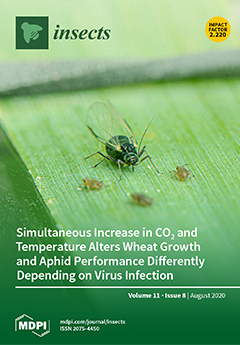Honey bees use several strategies to protect themselves and the colony from parasites and pathogens. In addition to individual immunity, social immunity involves the cumulative effort of some individuals to limit the spread of parasites and pathogens to uninfected nestmates. Examples of social immunity in honey bees that have received attention include hygienic behavior, or the removal of diseased brood, and the collection and deposition of antimicrobial resins (propolis) on interior nest surfaces. Advances in our understanding of another form of social immunity, social fever, are lacking. Honey bees were shown to raise the temperature of the nest in response to temperature-sensitive brood pathogen,
Ascosphaera apis. The increase in nest temperature (−0.6 °C) is thought to limit the spread of
A. apis infection to uninfected immatures. We established observation hives and monitored the temperature of the brood nest for 40 days. This observation period was broken into five distinct segments, corresponding to sucrose solution feedings—Pre-Feed, Feed I, Challenge, Feed II, and Post-Feed.
Ascosphaera apis was administered to colonies as a 1% solution of ground sporulating chalkbrood mummies in 50%
v/
v sucrose solution, during the Challenge period. Like previous reports, we observed a modest increase in brood nest temperature during the Challenge period. However, all hives presented signs of chalkbrood disease, suggesting that elevation of the nest temperature was not sufficient to stop the spread of infection among immatures. We also began to explore the molecular mechanisms of temperature increase by exposing adult bees in cages to
A. apis, without the presence of immatures. Compared to adult workers who were given sucrose solution only, workers exposed to
A. apis showed increased expression of the antimicrobial peptides abaecin (
p = 0.07) and hymenoptaecin (
p = 0.04), but expression of the heat shock response protein
Hsp 70Ab-like (
p = 0.76) and the nutritional marker vitellogenin (
p = 0.72) were unaffected. These results indicate that adult honey bee workers exposed to a brood pathogen elevate the temperature of the brood nest and initiate an immune response, but the effect of this fever on preventing disease requires further study.
Full article






